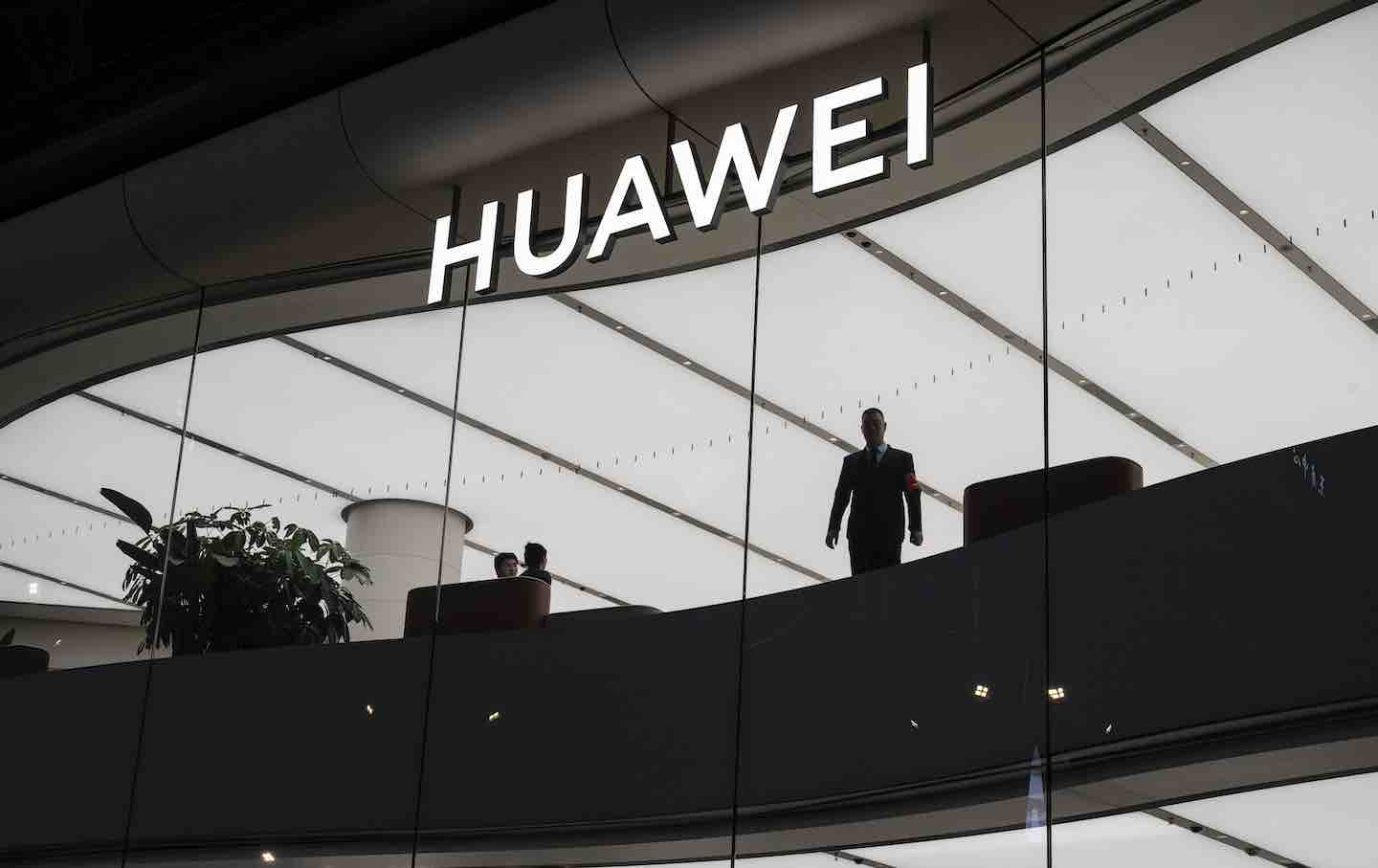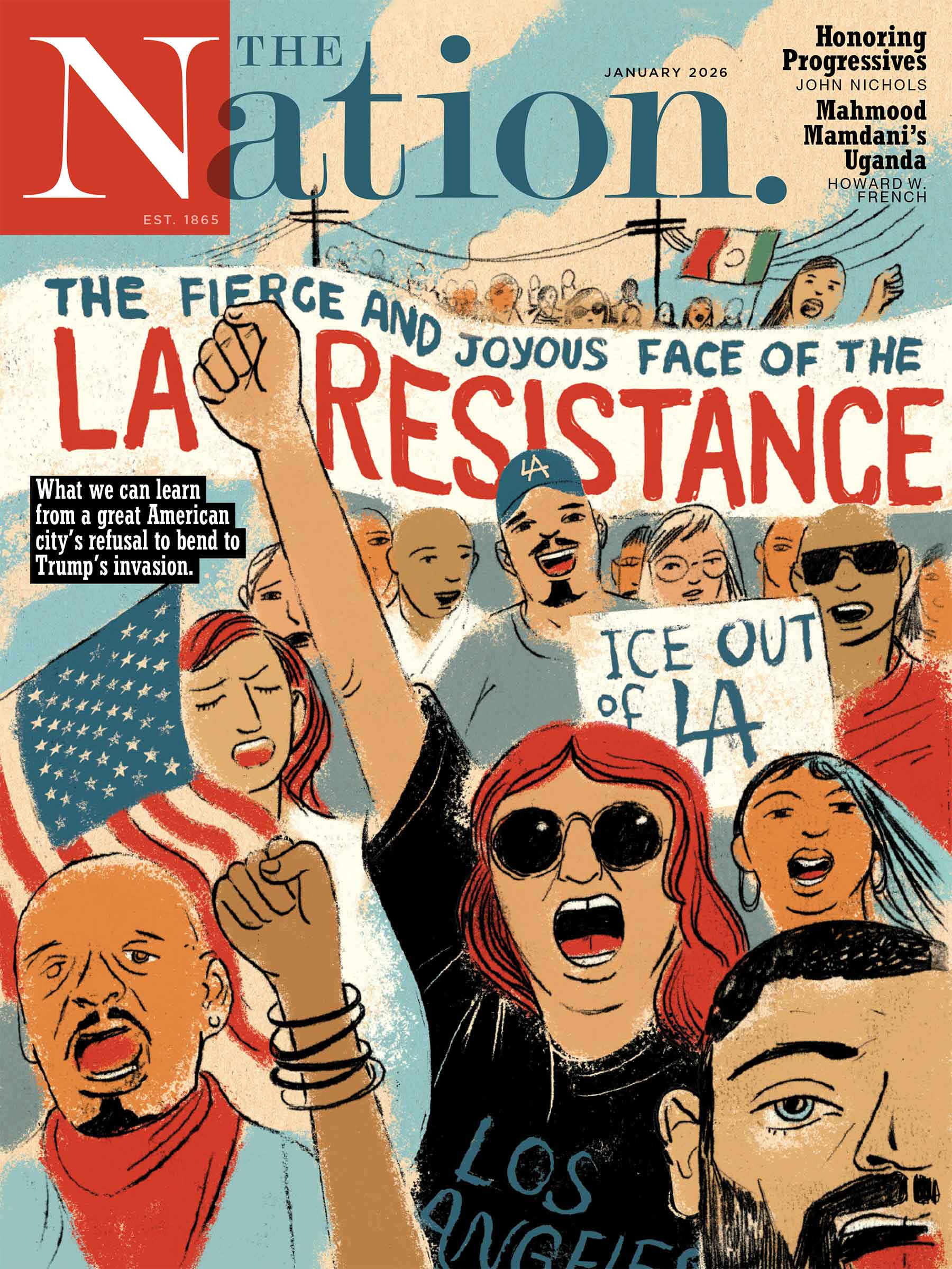Want to Understand the New Cold War? Look to Huawei.
The tech company has come to symbolize the ongoing struggle between America and China.

A Huawei store in Beijing, 2024.
(Kevin Frayer / Getty Images)America’s political and economic elites were once unruffled by the rise of China. Yes, Chinese GDP was growing fast, and yes, China’s share of global trade was growing equally rapidly. But this did not—or, at least, did not seem to—challenge America’s ongoing economic dominance. After all, the dollar was still king. The size and depth of China’s stock market continued to be dwarfed by the United States’. GDP per capita still weighed heavily in America’s favor. And the acknowledged global heavyweights of Big Tech—Alphabet, Apple, Amazon, Meta, Microsoft—were American companies one and all. The basic posture vis-à-vis China was the following: You keep producing all that cheap stuff, we’ll keep on buying it, and you keep on financing the deficits that we accrue in the process.
Books in review
House of Huawei: The Secret History of China’s Most Powerful Company
Buy this bookOver the last decade, all of this has unraveled. During his first term in the White House, Donald Trump introduced a series of tariffs on Chinese imports, which sparked retaliatory measures from China and growing talk of a “trade war.” Under Joe Biden, the inflammatory language of the Trump 1.0 era became less conspicuous. Rather, in a break with the hegemony of neoliberalism, the Biden White House hailed a renaissance in “industrial policy”; his flacks talked about no longer being able to rely on market mechanisms to guide investment. But even if the tone had changed, the policy content was not much different: China was in the crosshairs. If anything, Biden’s China tariffs were more severe than those he inherited. In mid-2024, tariffs on Chinese steel and aluminum were raised to 25 percent, on solar cells and panels to 50 percent, on electric vehicles to 100 percent; and in a parting gift to his successor, in January 2025, just as Biden was leaving office, a 50 percent tariff on Chinese semiconductors went into effect.
Notably, green technology was at the heart of Biden’s trade and China policy. In explaining his tariff hikes and their sectoral concentration, the Biden team repeatedly invoked the climate crisis and the energy transition, arguing that the only successful and sustainable global transition would be one where green technologies were not monopolized by a single country. US officials were well aware that monopolization was something that China was close to actually achieving. By 2023, China controlled the production of around 90 percent of the world’s rare-earth elements used in clean-energy products and at least 80 percent of the global solar-panel supply chain, with only slightly lower shares in wind turbines and EV batteries. Washington also looked with something like awe at China’s build-out of solar and wind power: The year after Biden’s historic “climate bill,” the Inflation Reduction Act of 2022, was passed to great domestic fanfare, China installed 10 times as much net new renewable capacity as America did.
Under Trump 2.0, all emphasis on green technology has of course been buried (at least rhetorically, since the tariffs on China’s green tech were retained). But the tariff saber-rattling has nonetheless escalated into all-out trade warfare. In February, a 10 percent tariff was imposed on Chinese imports across the board, and in March, this was increased to 20 percent. Trump was just getting started, however: April 2, his “Liberation Day,” saw the blanket tariff rate on China raised to 54 percent; and at the time of this writing, after retaliatory Chinese measures, the US tariff rate on Chinese imports effectively totals 145 percent. What is increasingly clear is that after decades of cautious sparring, the rivalry between America and China—as the US regards it, at any rate—has become a battle for global economic supremacy. Certainly, the Trump administration has targeted many other countries too, but China is plainly the main antagonist. Not for nothing has the Chinese government accused the United States of “unilateral bullying.”
What is also clear, though, is that underneath America’s bluster lurks a very real and very understandable fear: namely, that this is a battle that America might not win. In fact, more than that, this is a battle that America might have already lost; all the joking on social media that the United States has entered its own “Century of Humiliation”— China’s lasted from the mid-19th to the mid-20th century—cuts to the quick precisely because it expresses very real anxieties.
If one company symbolizes the ongoing struggle between America and China, that company, arguably, is Huawei. In its early years, after it was founded in 1987, Huawei—a Chinese tech firm that focuses on telecommunications—was largely ignored in the US, to the extent that it was even acknowledged. In the 2000s and early 2010s, as the company grew and expanded, including in the United States itself, American business and policy elites generally tolerated Huawei, perceiving it, at worst, as an irritant. But since Trump’s first term as president, a new era has begun. Endlessly challenged and vitriolically attacked, Huawei has ascended to the status of Public Enemy No. 1, the very apotheosis of the Chinese “threat.”
So why is Huawei treated with such hostility by US policymakers? Partly it’s about geopolitics. Though Huawei is an increasingly diversified enterprise, its main business, generating over half of total revenue, is the design, manufacture, and sale of telecom equipment such as networking infrastructure and the provision of ancillary services. Communications networks, of course, are integral to the ways in which states eavesdrop and spy on one another. America’s fear is that Huawei could or already does allow its products to be used to nefarious ends by the Chinese government. Ergo, it is deemed a threat to US national security.
It is with this aspect of Huawei’s role in US-China relations that Eva Dou, a reporter for The Washington Post, is principally concerned in her new book, House of Huawei: The Secret History of China’s Most Powerful Company. It has never been a secret that Huawei’s technologies are widely embedded in the contemporary surveillance state. The company has, for instance, been a major player since the 2000s in the international market for the chips used in surveillance cameras; Huawei was one of eight companies selected by Beijing in 1996 for a $1 billion national semiconductor development program. In China itself, what proved an especially lucrative opportunity for Huawei was President Xi Jinping’s launch in 2015 of a program—dubbed “Sharp Eyes”—aimed, Dou writes, at “blanketing the country with a network of security cameras.” In 2020, it was announced that China’s capital had no more blind spots: “Electronic eyes were watching over 100 percent of Beijing.” The same year, the Post revealed that Huawei had knowingly countenanced the use of its technology to track members of the Uyghur ethnic minority, prompting the French soccer star Antoine Griezmann to terminate his sponsorship deal with the company.
While the Uyghur revelations certainly hardened what by that point was a growing US-led international turn against Huawei, policymakers in America and other Western markets have always been much more concerned about the security-related and political implications of Huawei’s presence in their own territories. Could Huawei’s gear be hacked, leading to network disruption? Could the Chinese government listen in on international network users? From the American perspective, the biographic details of Huawei’s legendary founder and CEO, Ren Zhengfei—a background in the military (the Engineering Corps) and a member of the Chinese Communist Party since 1978—only redoubled the grounds for suspicion.
“With Huawei increasingly integrated into global networks,” Dou writes of developments in the mid-2000s, “it was being watched closely by spy agencies.” Statements along these lines pepper the book; by the end, the reader may wonder why Dou spends quite so much time on the cloak-and-dagger stuff, given that she never does unearth a smoking gun of any kind. Nonetheless, she is quite right to highlight the staggering hypocrisy of the US government’s moral grandstanding about alleged Chinese espionage machinations. As the 2013–14 Snowden leaks demonstrated, America’s own National Security Agency had successfully infiltrated Huawei several years previously and was using its infrastructure to spy not just on the company but on a range of other public- and private-sector entities, both in China and around the world. “The irony,” as Huawei’s US spokesman, William Plummer, put it at the time, “is that exactly what they are doing to us is what they have always charged that the Chinese are doing through us.” No wonder, remarks Dou, that Washington had been “so confident that Beijing could use Huawei’s gear for snooping: the NSA had been doing exactly that for years.”
For all the security concerns, however, the fact that Huawei is regarded as such a threat has to do with much more than “just” geopolitics. Equally important, and perhaps even more so, is the brute fact of Huawei’s staggering commercial success. One suspects that, consciously or otherwise, anxiety about Huawei’s competitive accomplishments is sometimes dressed up as a concern with “safety”: Far easier for the American mind to invoke a surveillance bogeyman than to admit to trepidatious reverence at Chinese business prowess.
As late as the turn of the millennium, the international telecommunications hardware market—Huawei’s home turf—continued to be dominated by Western firms such as Alcatel, Ericsson, Lucent, and Nortel. But the first decade of the new millennium began to see a changing of the guard. A seminal moment, as Dou tells it, came with Huawei’s first major breakthrough in the West, when, in 2005, the company won a lucrative bid to upgrade the network of BT, Britain’s largest supplier of telephony services. Opening the door to, among others, the French and Spanish markets, the BT deal was the “beginning of the end for several of Huawei’s Western rivals,” who simply couldn’t compete with the company at its “budget price points.” By 2012, Huawei was the world’s largest vendor of telecommunications networking hardware. Having also successfully made the move into consumer electronics—branded household gadgets “could help Huawei soften its image overseas,” Dou notes—the Chinese firm was, for good measure, now the world’s third-largest smartphone maker, behind only Apple and Samsung.
Popular
“swipe left below to view more authors”Swipe →Huawei has succeeded internationally despite America’s best efforts, especially in the past decade, to prevent it from doing so. The company had been on Washington’s radar since the late 1990s, not least because of its expansion in those years into markets presided over by what the US deemed “rogue” regimes, among them Iraq and Russia. The result was that, even after Huawei successfully made big sales in other Western territories after establishing its foothold in Britain, America would remain the one major market in which it failed to make significant inroads, having to satisfy itself there with sales to second- or third-tier network operators. As a potential supplier, the Chinese company was simply beyond the pale for America’s telephony market leaders, for whom political optics and relationships are considered just as important as capital costs and network quality.
During the first Trump administration, the US expanded its campaign against Huawei on two new fronts. It imposed export controls, specifically by banning US companies from supplying Huawei with critical components, as they had been doing since as early as 1993, when Huawei established its first US subsidiary in California. And, with some notable successes, the US government also began applying substantial pressure on countries like Australia, Britain, and Canada to follow its lead in blackballing Huawei in their domestic markets, focusing on those countries’ tendering of contracts to build 5G networks. Huawei, however, has prevailed nonetheless, even as there is no doubt that America’s resistance has crimped the scope of its achievements. “The West was continuing to grow more inhospitable toward Huawei,” Dou says by way of bringing her story up to the time of her writing, in 2024. “Yet—almost incredibly—Huawei was still number one in the world in 5G gear sales.”
Huawei’s prevailing in the face of the United States’ concerted opposition shows that America is not as powerful or persuasive as it certainly likes to imagine that it is: Not everyone, even its (erstwhile) “friends,” kowtows to its demands. Furthermore, and perhaps more significantly still, the Huawei story demonstrates that in the 21st century, non-Western companies are able to be enormous commercial successes—to be, in fact, world leaders in their chosen industry sectors—while having the US and several other leading Western markets essentially closed off to them. That, in itself, is a profound statement on the shifting of the world economic order, and one that Trump and his cronies evidently seem to be ignoring—or perhaps are unable to understand—as they set about alienating long-time commercial and political allies, in addition to the list of long-time adversaries, by unleashing an all-encompassing trade war the likes of which the world has not seen since the early 20th century. In the postwar era, it would have been unthinkable that a company could have ascended to global market leadership in any area of the economy without a major presence in the United States, Europe, or (more likely) both. That is no longer true. Alongside East Asia and Africa, it is the Middle East, with all its natural-resource-based riches, that represents, in Dou’s words, “the beating heart of Huawei’s global empire.”
What is also maddening to Huawei’s American critics is that it has done all this while thumbing its nose at American-style capitalism. For many years, there was widespread expectation around the world, and among many in China itself, that Huawei would proceed to an IPO. This was assumed to be its “natural” evolutionary terminus, the inevitable result of the company’s inculcating, and eventually adopting, the Western gospel of shareholder value. But Huawei never did become a public company, and it never prioritized shareholder value to the exclusion of all else. It was, and is, something else entirely—and that something else has proved a great commercial success. What do we know about the model?
Huawei began life as a contract manufacturer. That is, at the start, it did not have its own products, but manufactured those of others—including, most notably, simple analog telephone switches capable of routing and connecting, at most, a few dozen phone calls, which were sold to the likes of small offices and hotels. Huawei was initially a private company, controlled top to bottom by Ren Zhengfei himself and capitalized with the princely sum of 21,000 yuan provided by Ren and five private investors. Five years after its founding, by which time it had developed and begun to sell a first switch of its own (the BH-03), Huawei converted in 1992 to a “collectively owned enterprise,” a company structure that furnished both a degree of political patronage and a set of broader financing opportunities—and which, in Huawei’s case, appeared to entail a more democratic form of management in the shape, in particular, of a powerful workers’ committee.
A stimulus for further change came in 1994, a landmark year for China’s corporate landscape, when the country’s new Company Law introduced limited-liability companies (LLCs) with the aims of encouraging greater investment, aligning China’s corporate governance with international standards, and facilitating an accelerated transition to a market economy. Ren was intrigued but not immediately convinced, electing to hire a team of Beijing business professors to help him strategize restructuring opportunities and map out a new future for the firm. Huawei did become an LLC (and remains one today), but only in 1997, at which point the existing employee shareholdings, of which there were a large number, were consolidated into a single “trade union” holding. Meanwhile, the professors’ much-anticipated blueprint, the “Huawei Basic Law,” was adopted the following year. Profit would be just one objective among many; more important was the reinvestment of that profit to drive growth—fully 10 percent of sales were to go into R&D.
Dou argues that Huawei is ultimately best understood as a company made in the image of the nation. Its goal is not to increase shareholder value so much as “to ensure its own long-term survival,” as is also true, she points out, of the ruling Communist Party. The secret of Huawei’s success, Dou writes, is its “ability to accomplish titanic tasks at almost impossible speeds by getting everyone to pull in unison.” Reading these words, one can’t help but think, yet again, of China’s titanic ongoing achievements in rolling out renewable energy capacity on a gargantuan scale and at almost impossible speeds.
But Dou is also forthright about the considerable downsides of this business approach. Success achieved in the manner of Huawei, she observes, “can come at crushing costs for the individuals involved.” Huawei “fetishized long work hours”—the company’s engineers were accustomed to keeping mats by their desks so they could nap on the floor rather than going home at night. Perhaps worse was that an aggressive, survival-of-the-fittest “wolf culture” was encouraged not just externally, in the rivalry with competitors, but internally, among colleagues. And it surely did not help employees’ mental health to know that the prospect of involuntary redundancy constantly hovered in the background: Huawei, Dou notes, “repeatedly pressured its staff into mass resignations.”
In any case, enough is known about the psychological effects to leave the reader in no doubt about the sheer corrosiveness of the Huawei model from a social perspective. Dou reports a “string of ‘unnatural’ deaths,” including suicides, among employees. She also cites the finding of a scholarly study that some two-thirds of Huawei’s senior management were suffering from a stress-related illness. Such figures hint at a milieu beside which even Wall Street’s famously pitiless working culture would likely look positively tranquil.
Huawei is a creature of Shenzhen, a city in the coastal province of Guangdong in South China. After the decommissioning of his military unit, the Engineering Corps, a thirtysomething Ren Zhengfei moved to Shenzhen in the early 1980s, initially assigned a job there at a subsidiary of the state-owned South Sea Oil Corporation, which was building a harbor to support offshore oil production. Following a “short and undistinguished” time in this position, Ren—who had made something of a name for himself in the military by building a precision air-pressure generator that he subsequently worked to commercialize—established Huawei. He was 42. He is still the company’s CEO today.
It is possible, perhaps even probable, that Huawei could not have become what it did except in Shenzhen. Abutting Hong Kong to its immediate south, Shenzhen was designated as China’s first-ever “special economic zone” in 1980. At the time, it had a population of around 30,000. Physically walled off from the rest of China by barbed-wire fences, it was also walled off figuratively: While the post-Mao reformism of Deng Xiaoping initially proceeded slowly in the country at large, everything was on fast forward in the “wild west” that was late-20th-century Shenzhen, where the normal rules did not apply and an “anything goes” approach prevailed. The city was “ground zero,” Dou writes, for China’s “grand experiment with capitalism.” Ren and Huawei exploited this business environment maximally, as did many others. In the 1980s through the 2010s, Shenzhen was one of the fastest-growing cities in the world: By 2020, its 30,000 inhabitants had become 17.4 million, making the city by then China’s third-largest.
Of course, the Chinese “capitalism” with which Ren and others experimented in booming Shenzhen was and is a very special version, and Dou does a wonderful job of picturing its sheer foreignness and oddness, when seen through Western eyes. In no respect, perhaps, is the foreignness of Chinese capitalism more striking than in terms of the relation between firms and the Chinese Communist Party. All companies with a certain proportion of employees who are party members are required to establish an internal party “committee” that gives the CCP a formal role in the company. Huawei set up its committee in 1996, with Ren himself serving as the first secretary. Huawei’s committee infused the company with the CCP’s signature themes of “patriotism, struggle for the greater cause, and self-sacrifice”—no doubt the mats by the engineers’ desks and the surging mental health problems were justified accordingly—and its influence appears only to have grown with time. In 2007, the committee was granted veto power over Huawei’s executive appointments.
Indeed, as Western observers have never tired of remarking, Huawei’s fortunes were bound up with the party, and with the state more generally, from the start. The mistake that those observers have made, however, is to think about the Chinese state primarily, and sometimes only, in terms of Beijing, which is to say the central government. To do so, Dou shows us, is to miss one of the most important parts of the Huawei story.
The specific products that were key to making Huawei a major commercial force both nationally and internationally were digital telephone switches. Able to route and connect thousands (or even millions) of calls at once compared with the mere dozens handled by analog versions, digital switches constitute the nerve centers of modern public communications networks, directing and managing the flow of data as well as voice packets. When Huawei began working in the early 1990s on the development of digital switches, that work was financed by a joint-venture company called Mobeco, established in 1993. The money behind Mobeco was provided by Huawei’s equity partners in the venture—namely, 17 provincial and municipal (that is, public) telecom bureaus.
When Huawei’s first proprietary digital switch (C&C08) went into production in 1995, the same public telecom bureaus that had helped finance its development were now in charge of buying it for their local telephone exchanges. Not only that, but, indirectly at least, they also found themselves manufacturing it: Huawei outsourced the production of C&C08 to Mobeco. In short, what Western observers might understand as conflicts of interest abounded. And Huawei then doubled down, as the success of Mobeco prompted it to expand the model: It set up more such joint ventures with local governments around the country. Dou characterizes these as “Huawei’s ‘marriage’ to the state.” This is not to say that Huawei didn’t have close and efficacious relationships with other arms of the state—for example, “in 2005,” Dou writes, “the China Development Bank, a Beijing-controlled policy bank, allocated a whopping $10 billion to fund Huawei’s overseas expansion.”
Despite documenting these various linkages between the company and the state, this is also, paradoxically, where House of Huawei is at its weakest. As Dou observes, amid the 1990s ferment of productive innovation in China, Huawei was one of four major domestic producers of telecom equipment to come to the fore, the others being Datang, Great Dragon, and ZTE. Why, out of these four, did Huawei emerge as the undisputed leader both domestically and, ultimately, internationally? Dou doesn’t—and arguably can’t—answer that question, because despite hinting that Huawei won simply by virtue of outcompeting its rivals, she never actually gets at the question of what “competition” means in the context of Chinese capitalism, saturated as that system is in political influence.
Scholars, however, have been exploring this question. The sociologist Kyle Chan, for instance, has examined the nature of competition in sectors of the Chinese economy in which state-owned enterprises (SOEs) play a significant role. His research is highly relevant to the case at hand: Datang, Great Dragon, and ZTE are all owned wholly or mainly by the state. Chan found that industries with a substantial SOE presence, telecommunications included, are characterized by what he calls “managed competition,” representing a blend of state oversight and competitive forces and combining innovation and efficiency, on the one hand, with control and planning on the other. In order to maintain a balance of competitive capabilities among industry actors and thus prevent the formation of monopolies, the state intervenes where necessary, Chan argues, to redistribute resources, personnel, and contracts.
There is very little analysis of this kind in House of Huawei. Dou has written a book that is much more interested in personalities, subterfuge, and geopolitics than it is in economics and competitive practice. She helps us understand why Huawei vaulted to the top of US policymakers’ fearful protectionist agenda, but less about how and why it vaulted to the top of the telecommunications industry against both national and international competitors. We are left with much still to understand about Huawei as a particular corporate embodiment of what is, in the Chinese case, a very particular type of capitalist social formation.
Disobey authoritarians, support The Nation
Over the past year you’ve read Nation writers like Elie Mystal, Kaveh Akbar, John Nichols, Joan Walsh, Bryce Covert, Dave Zirin, Jeet Heer, Michael T. Klare, Katha Pollitt, Amy Littlefield, Gregg Gonsalves, and Sasha Abramsky take on the Trump family’s corruption, set the record straight about Robert F. Kennedy Jr.’s catastrophic Make America Healthy Again movement, survey the fallout and human cost of the DOGE wrecking ball, anticipate the Supreme Court’s dangerous antidemocratic rulings, and amplify successful tactics of resistance on the streets and in Congress.
We publish these stories because when members of our communities are being abducted, household debt is climbing, and AI data centers are causing water and electricity shortages, we have a duty as journalists to do all we can to inform the public.
In 2026, our aim is to do more than ever before—but we need your support to make that happen.
Through December 31, a generous donor will match all donations up to $75,000. That means that your contribution will be doubled, dollar for dollar. If we hit the full match, we’ll be starting 2026 with $150,000 to invest in the stories that impact real people’s lives—the kinds of stories that billionaire-owned, corporate-backed outlets aren’t covering.
With your support, our team will publish major stories that the president and his allies won’t want you to read. We’ll cover the emerging military-tech industrial complex and matters of war, peace, and surveillance, as well as the affordability crisis, hunger, housing, healthcare, the environment, attacks on reproductive rights, and much more. At the same time, we’ll imagine alternatives to Trumpian rule and uplift efforts to create a better world, here and now.
While your gift has twice the impact, I’m asking you to support The Nation with a donation today. You’ll empower the journalists, editors, and fact-checkers best equipped to hold this authoritarian administration to account.
I hope you won’t miss this moment—donate to The Nation today.
Onward,
Katrina vanden Heuvel
Editor and publisher, The Nation
More from The Nation

Why “The Voice of Hind Rajab” Will Break Your Heart Why “The Voice of Hind Rajab” Will Break Your Heart
A film dramatizing a rescue crew’s attempts to save the 5-year-old Gazan girl might be one of the most affecting movies of the year.

How Laura Poitras Finds the Truth How Laura Poitras Finds the Truth
The director has a knack for getting people to tell her things they've never told anyone else—including her latest subject, Seymour Hersh.

Rob Reiner’s Legacy Can't Be Sullied by Trump’s Shameful Attacks Rob Reiner’s Legacy Can't Be Sullied by Trump’s Shameful Attacks
The late actor and director leaves behind a roster of classic films—and a much safer and juster California.

Blood Orange’s Sonic Experiments Blood Orange’s Sonic Experiments
Dev Hynes moves between grief and joy in Essex Honey, his most personal album yet.



